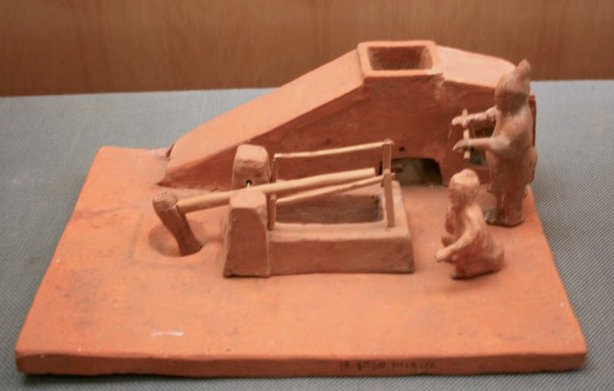Fengshanche on:
[Wikipedia]
[Google]
[Amazon]
Fengshanche () was a winnowing machine that was used in ancient China to separate the grain from the chaff or seed casings after harvest. The winnowing machine also had a rotary fan which had a blower that had a crank handle to create air to blow away the lighter seed casings to separate the husks from the pile of grain. Needham, Joseph (1965). ''Science and Civilization in China, Vol. IV: Physics and Physical Technology'', p.118. .

 The winnowing machine was referred and applied to grain cleaning based on the references in the book of ''
The winnowing machine was referred and applied to grain cleaning based on the references in the book of ''

Overview
Based on the archaeological evidence provided by pottery models of the winnowing machine, the winnowing machine was constructed within the courtyard wall that hadquerns
Quern-stones are stone tools for hand- grinding a wide variety of materials. They are used in pairs. The lower stationary stone of early examples is called a saddle quern, while the upper mobile stone is called a muller, rubber or handstone. The ...
and trip hammers placed near it. The machine also had a crank operated rotary fan with four blades, an air inlet, and hopper as well as a box, crank, and vanes. The device was able to operated by hands or feet. The crank consists of four to six vanes that are made of thin boards. When operated, grains are placed in the gap through the funnel where they fall down. The vanes would then spin and then separate the lighter husks by blowing them away with the grains with no husks that would fall to box's bottom.
History
Jijiupian
The ''Jijiupian'' is a Chinese character primer that was compiled by the Han dynasty scholar Shi You around 40 BCE. Similar to an abecedarium, it contains a series of orthographic word lists, categorized according to character radical, and brief ...
'' during the Western Han Dynasty. The pottery winnower model was used as a funeral object in the Central Plains. The ancient Chinese used their other invention of the crank handle and a rotary centrifugal fan and applied it to the design of the winnowing machine. Needham, Joseph (1965). ''Science and Civilization in China, Vol. IV: Physics and Physical Technology'', p.118. . Evidence of the rotary fan winnowing machine that makes use of the centrifugal principle can be traced back to the Western Han Dynasty with archaeological evidence provided by pottery models of the winnowing machine excavated from Western Han tombs in Luoyang, Henan in the early 1970s.
See also
*Agriculture in China
China primarily produces rice, wheat, potatoes, tomato, sorghum, peanuts, tea, millet, barley, cotton, oilseed, corn and soybeans.
History
The development of farming over the course of China's history has played a key role in supporting th ...
References
{{agriculture-stub Agricultural machinery History of agriculture in China Chinese inventions Han dynasty